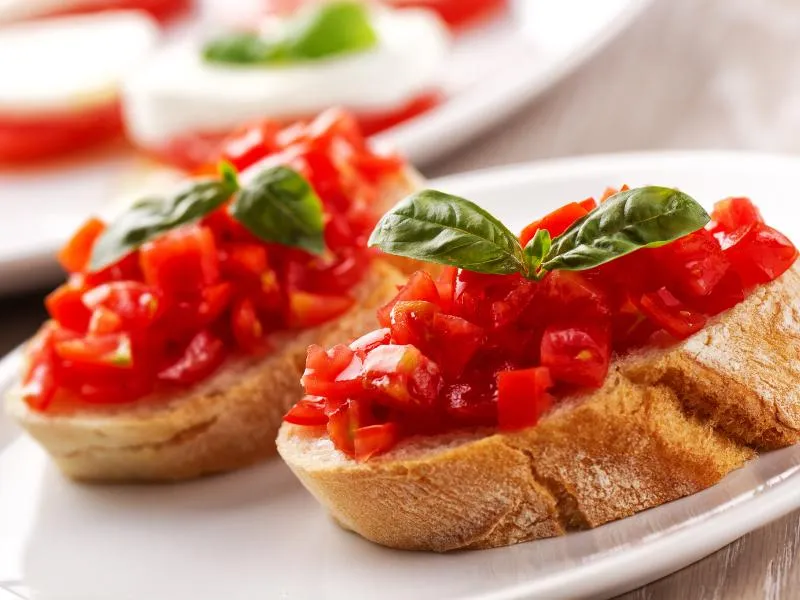Bruschetta
Toasted bread rubbed with garlic and topped with olive oil, tomatoes, and fresh basil.
👉 View Authentic Recipe 👈
About This Dish
Bruschetta originated in central Italy, particularly Tuscany, as a practical way for olive farmers to sample their freshly pressed oil on grilled slices of bread. Dating back to at least the 15th century, this rustic appetizer embodies the Tuscan philosophy of simple, high-quality ingredients combined to create extraordinary flavors.
The dish’s foundation consists of thick slices of crusty bread (traditionally from unsalted Tuscan loaves) that are grilled over hot coals, rubbed with raw garlic, and generously drizzled with new-season extra virgin olive oil and finished with a sprinkle of salt. While the tomato-topped version is now globally recognized, the original bruschetta was this simpler garlic-and-oil preparation.
Bruschetta serves as both an antipasto (appetizer) and a way to use day-old bread, highlighting the Italian tradition of not wasting food. During the late summer harvest, when tomatoes reach peak ripeness, the modern version with diced tomatoes, basil, and sometimes a splash of balsamic vinegar became popular throughout Italy, though purists in Tuscany might still prefer the traditional preparation.
🧑🍳 Analyzed by CucinaBot
Why This Dish Works
Bruschetta exemplifies the culinary principle of complementary contrasts: the crunchy texture of toasted bread against soft, juicy tomatoes; the pungency of raw garlic mellowed by sweet, fruity olive oil; and the bright acidity of tomatoes balanced by the richness of olive oil. These elements create a perfect flavor harmony while the porous structure of toasted bread absorbs the olive oil and tomato juices without becoming soggy, delivering a concentrated burst of Mediterranean flavors in each bite.
Key Success Factors
- Bread Quality: Use hearty, rustic bread with a firm structure and substantial crust that can withstand toasting and toppings without collapsing
- Toasting Method: Proper charring (preferably over open flame or very hot grill) develops complex flavors through caramelization without drying out the interior
- Raw Garlic Application: Rub cut garlic directly on warm toast for proper flavor infusion - never use pre-minced or garlic powder
- Tomato Preparation: When using tomatoes, they must be seeded and drained to prevent sogginess, and served at room temperature for maximum flavor
Common Pitfalls
Many non-authentic preparations overcomplicate this fundamentally simple dish with cheese, excessive balsamic reduction, or pre-made toppings. The most common mistake is using thin, soft bread that becomes soggy, or serving bruschetta on cold bread, which prevents proper absorption of the olive oil and causes the garlic flavor to be harsh rather than integrated. Another frequent error is serving tomato-topped bruschetta too far in advance, which ruins the textural contrast that makes the dish special.
How to Judge Authenticity
When reviewing recipes, look for these markers of authenticity:
- Specifies thick-cut (at least 1/2 inch) rustic bread like ciabatta or a country loaf
- Calls for rubbing raw garlic cloves directly on the hot toasted bread
- Emphasizes high-quality, extra virgin olive oil as a prominent ingredient, not just a minor addition
- If including tomatoes, specifies they should be ripe, fresh, seeded, and at room temperature
- Maintains simplicity with minimal ingredients (bread, garlic, oil, salt, and possibly tomatoes and basil)